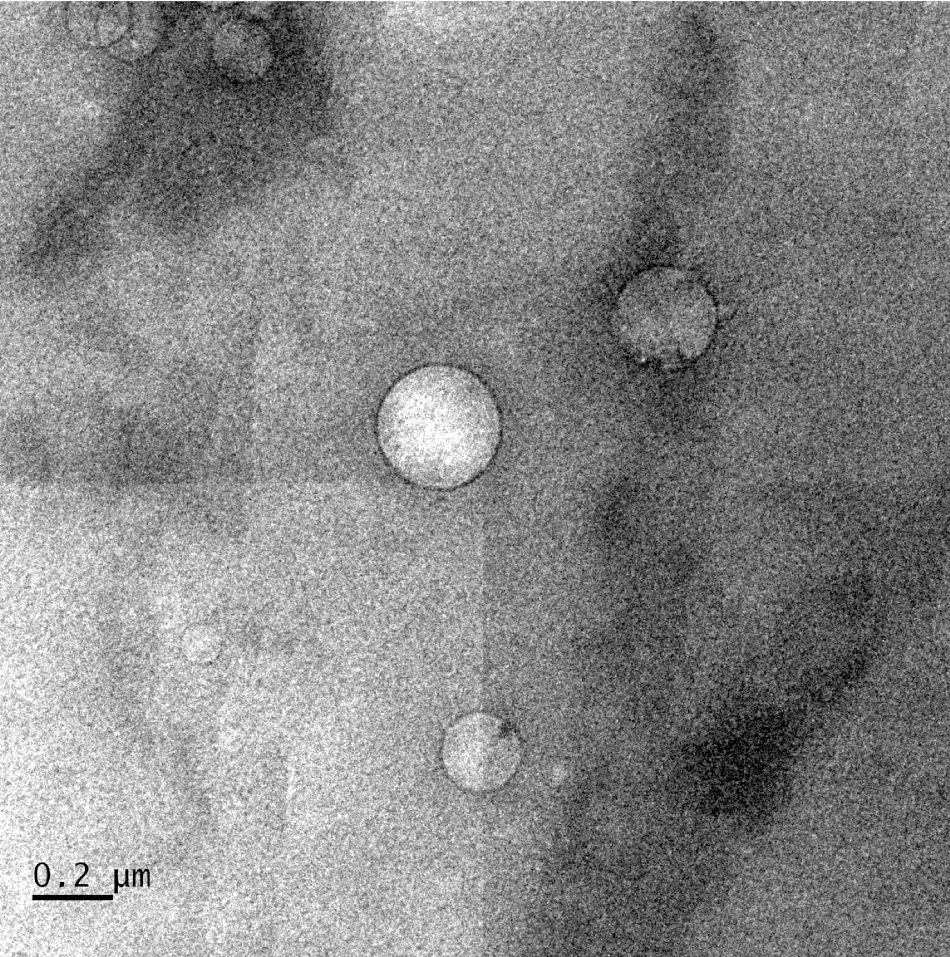Mar 3 2020
Researchers at Rice University’s Brown School of Engineering have now found that oil and water, in fact, mix, somewhat. They demonstrate that microscopic saltwater droplets can emulsify crude oil when they have a suitable composition. It is crucial in order to understand how they gel in order to improve oil recovery.
 Low-salinity brine injected into crude oil forms nanoscale droplets that help separate oil from rock in reservoirs, according to Rice University engineers. The black ring around the droplets, seen in a cryogenic electron microscope image, is asphaltene. Image Credit: Wenhua Guo/Rice University.
Low-salinity brine injected into crude oil forms nanoscale droplets that help separate oil from rock in reservoirs, according to Rice University engineers. The black ring around the droplets, seen in a cryogenic electron microscope image, is asphaltene. Image Credit: Wenhua Guo/Rice University.
Sibani Lisa Biswal, a chemical and biological engineer at Rice University, and her team contributed considerable efforts to characterize the three elements most vital to oil recovery: water, rock, and the crude itself.
It was established that wells were more productive when water with the optimal salt concentration is carefully matched with both the oil and the rock, carbonate, or sandstone formation. If emulsion droplets can be formed by the low-salinity brine in a particular crude, the brine seems to also modify the rock’s wettability. Wettability is the factor that governs how easily the rock releases oil.
The researchers’ study was reported in the open-access Nature journal Scientific Reports.
According to Jin Song, co-lead author of the study, the first clues of the effect of seawater came from wells in the North Sea. “Oil companies found that when they injected seawater, which has relatively low salinity, oil recovery was surprisingly good,” he stated.
Despite that insight, he noted that studies in this area are limited. “Usually in the oil and gas industry, when they’re looking into low-salinity water, they tend to focus on the effect of the brine and ignore the effect of the oil,” stated Song, who earned his Ph.D. at Rice University this year and is currently a researcher at Shell.
So people haven’t been able to find a good indicator or any correlation between the effectiveness of low-salinity water and experimental conditions. Our work is the first to identify some of the properties of the oil that indicate how effective this technique can be in a specific field.
Jin Song, Study Co-Lead Author, Rice University
The researchers tested the dispersion of the injected brine and its impact on the interfacial tension and electrostatic interactions of the oils with rock.
“How to characterize wettability accurately is a challenge,” Biswal said. “Oftentimes, we assume that reservoir rock underground are under a mixed-wet state, with regions that are oil-wet and regions that are water-wet.”
If you can alter your oil-wet sites to water-wet sites, then there’s less of a driving force to hold the oil to the mineral surface. In low-salinity water injection, the brine is able to displace the trapped oil. As you change from oil-wet to water-wet, the oil is released from the mineral surface.
Sibani Lisa Biswal, Chemical and Biological Engineer, Rice University
Two brines were tested by the team, one with high salinity and one with a quarter of seawater’s salinity, on Indiana limestone cores against six types of crude oils from the Southeast Asia, Gulf of Mexico, and the Middle East, as well as a seventh type of oil with asphaltene included as an additive. In contrast to the low-salinity samples, the high-salinity brine was found to evidently inhibit water droplets from emulsifying in crude.
Rice research scientist Wenhua Guo endeavored to gain better insights into the thermodynamic nature of the emulsion by capturing cryogenic electron microscope images of nearly 100 mixtures of oil and water. Since oil is opaque, the researchers had to place the samples in very thin containers, which were then frozen using liquid nitrogen to maintain them stable for imaging.
“This is the first time anyone has seen these water droplets inside crude oil,” stated Biswal. “They spontaneously arise inside the crude oil when you expose it to a low-salinity brine.”
The images displayed droplets with a differing size from 70 nm to just above 700 nm. According to Biswal, chemical surfactants, also called soap, can also loosen oil in a reservoir in a better way. However, they are exorbitantly expensive.
You can change the salt concentration to modify the composition of the brine and get the same effect as in including the detergent. So it’s basically a low-cost technique trying to achieve the same goal as detergent.
Sibani Lisa Biswal, Chemical and Biological Engineer, Rice University
The co-lead author of the study is Rice graduate alumna Sara Rezaee. Co-authors of the study include Rice alumna Brianna Hernandez; research scientist Maura Puerto; Francisco Vargas, the Louis Own Assistant Professor of Chemical and Biomolecular Engineering; and George Hirasaki, the A.J. Hartsook Professor Emeritus and a research professor of chemical and biomolecular engineering.
The study was supported by the Abu Dhabi National Oil Company and Rice’s Consortium for Processes in Porous Media.